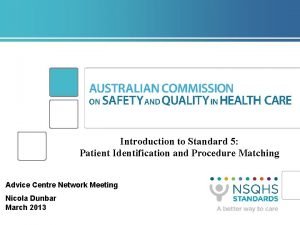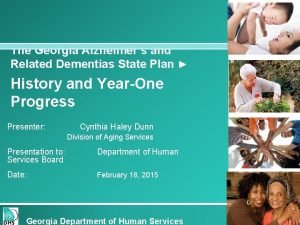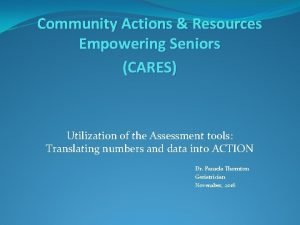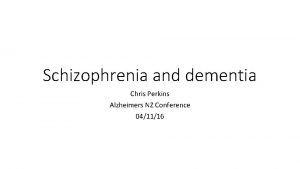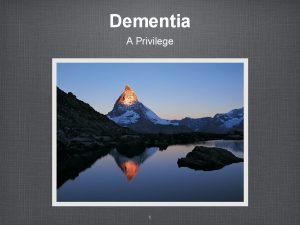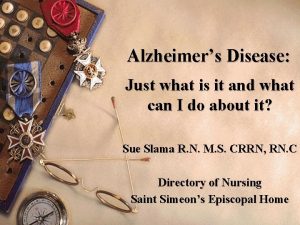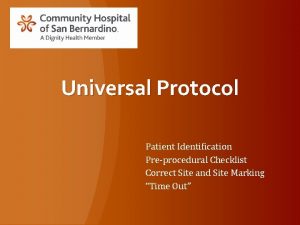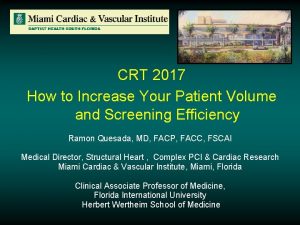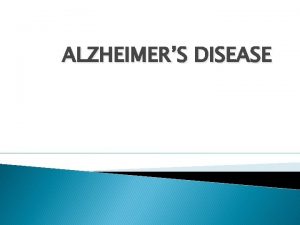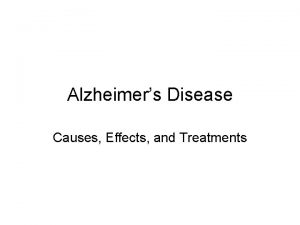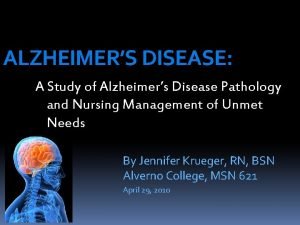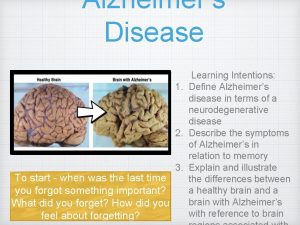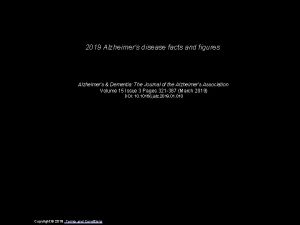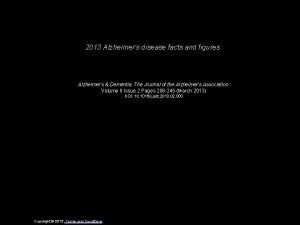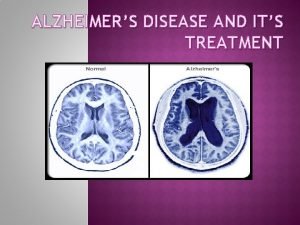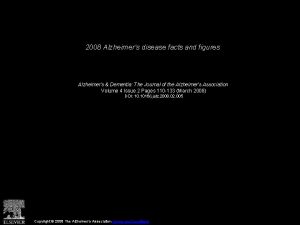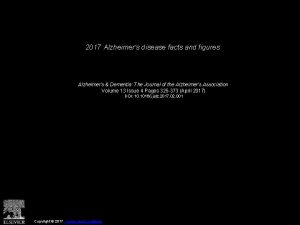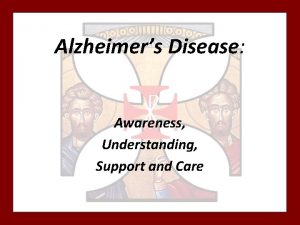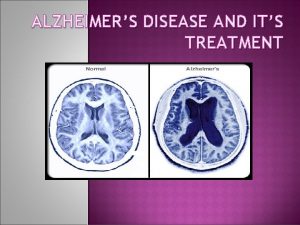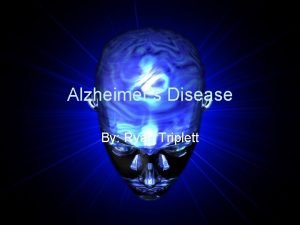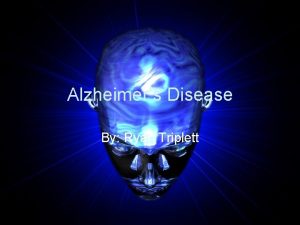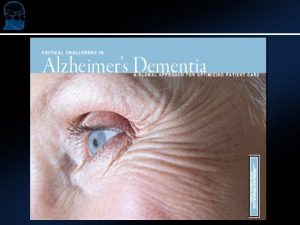Patient Identification and Initial Strategies Alzheimers Disease AD
















- Slides: 16

Patient Identification and Initial Strategies

Alzheimer’s Disease (AD): More Than Just Memory Loss ► AD is a progressive, degenerative disease involving: l Loss of memory and other cognitive functions l Decline in ability to perform activities of daily living l Changes in personality and behavior l Increases in resource utilization l Eventual nursing home placement

Alzheimer’s Disease Overview ► Progressive, degenerative brain disease characterized by an increasing loss of memory & other cognitive functions ► Characterized by changes in activities of daily living (ADL), behavior & personality, cognition including judgment – ABCs ► Most common cause of dementia among people aged 65 or over

Current Prevalence of AD ► AD is the fourth leading cause of death due to disease for people > 65 years of age in the United States 1 ► Approximately 4 million people in the United States have AD 2 1. Murphy SL. Natl Vital Stat Rep. 2000; 48: 1 -106. 2. Evans DA et al. Milbank Quarterly. 1990; 68: 267 -289.

AD Is the Most Prevalent Type of Irreversible Dementia Va. D, vascular dementia; DLB, dementia with Lewy bodies; FTD, frontotemporal dementia. reflects difficulties diagnosing/reporting dementias; only estimations of prevalence can be made. Irreversible dementias (%) 100 80 60 40 20 0 AD Va. D DLB Guttman R et al. Arch Fam Med. 1999; 8: 347 -353. Mc. Keith IG et al. Neurology. 1996; 47: 1113 -1124. Cherrier MM et al. J Am Geriatr Soc. 1997; 45: 579 -583. FTD Other

Mortality Due to AD: Impact of Age Rate per 100, 000 population 1, 000 10 100 1 0. 01 Under 45 45– 54 55– 64 65– 74 75– 84 Age (years) Reprinted with permission from Hoyert DL et al. Natl Vital Stat Rep. 1999; 47: 1 -104. 85+

Cost of AD in the US ► Annual treatment costs ~ $100 billion $18, 408/patient per year for mild AD l $30, 096/patient per year for moderate AD l $36, 132/patient per year for severe AD l Leon J et al. Health Aff (Millwood). 1998; 17: 206 -216.

Does Treatment Affect the Cost of AD? ► Savings are small for mild and very severe AD ► Prevention of even a small decline in cognition for patients with moderate AD would save ~ $3, 700 per patient annually ► Relatively small improvements in patients with moderate AD would save ~ $7, 100 per patient annually Ernst RL et al. Arch Neurol. 1997; 54: 687 -693.

Who Are the Caregivers? ► The overwhelming majority of patients live at home and are cared for by family and friends l l l 77% are women 73% are over 50 years of age 33% are the sole providers 45% are children of the patient 49% are spouses Remainder are close family members or friends Consumer Health Sciences, LLC. Princeton, NJ; December 1999.

Caregiver Burden ► Caregivers spend from 40– 100 hours per week with the patient ► 90% are affected emotionally (frustrated, drained) ► 75% report feeling depressed; 66% have significant depression ► Half say they do not have time for themselves and that the stress affects family relations ► Many experience a significant loss of income Coping. Available at: http: //www. alzheimers. com. Accessed September 2000.

Factors That Create “Breaking Point”for Caregiver ► Amount of time spent caring for the patient ► Loss of identity ► Patient misidentifications and clinical fluctuations ► Nocturnal deterioration of patient Annerstedt L et al. Scand J Public Health. 2000; 28: 23 -31.

Neuropathological Changes Characteristic of AD Normal AP AP = amyloid plaques Courtesy of George Grossberg M. D. ; St. Louis University AD NFT = neurofibrillary tangles

Key Risk Factors for AD ► Primary risk factors l l ► Age Family history Genetic marker such as APOE-4, trisomy 21, mutations in presenilin 1, 2 Cardiovascular risk factors e. g. hyperlipidemia/ hypertension (the role of statins and omega 3 fatty acids) Possible risk factors l l l Head trauma Low level of education Depression Increased zinc? Increased homocysteine (the role of B-vitamins, e. g. Folic acid)

AD Is Often Misdiagnosed Patient initially diagnosed with AD Patient’s first diagnosis other than AD 35% 14% No 72% Yes 28% 14% 9% 7% 21% Dementia (not AD) Depression Stroke No diagnosis Normal aging Other Source: Consumer Health Sciences, LLC. Alzheimer’s Caregiver Project. 1999.

Treatment Alternatives ► Symptoms Non-pharmacological l Neuroleptics l Anti-depressants l Anti-convulsants l Ch. EIs l NMDA receptor antagonists l

AD Treatment Algorithm Stage of AD Treatment Options Mild Ch. EI Moderate Ch. EI/ Memantine (alone or in combination) Severe Memantine (alone or in combination)
 Patient identification and procedure matching
Patient identification and procedure matching Communicable disease and non communicable disease
Communicable disease and non communicable disease Georgia alzheimers planning
Georgia alzheimers planning Fast scale
Fast scale Alzheimers sjukdom
Alzheimers sjukdom Alzheimers nz conference 2020
Alzheimers nz conference 2020 Site:slidetodoc.com
Site:slidetodoc.com Alzheimers society contented dementia
Alzheimers society contented dementia Alzheimer's eye test joke
Alzheimer's eye test joke Presumptive identification vs positive identification
Presumptive identification vs positive identification Universal protocol checklist
Universal protocol checklist Patient 2 patient
Patient 2 patient Patient counselling for peptic ulcer disease
Patient counselling for peptic ulcer disease Strategies to increase patient volume
Strategies to increase patient volume System planning and initial investigation
System planning and initial investigation Deped transmuted grade
Deped transmuted grade Initial velocity and final velocity formula
Initial velocity and final velocity formula
